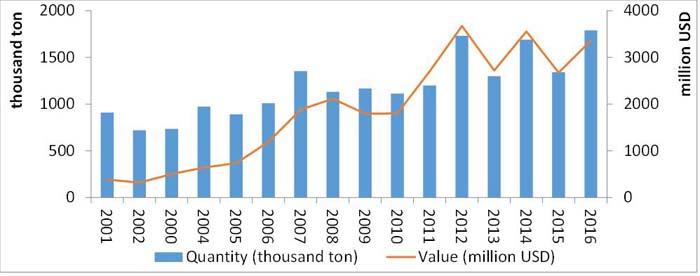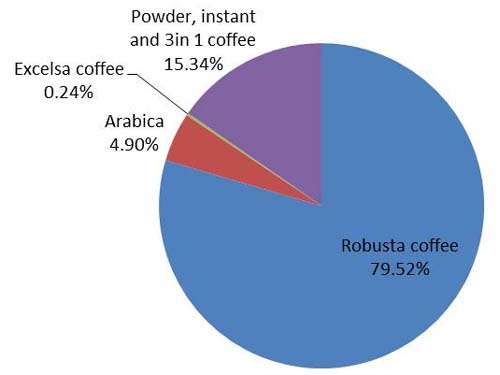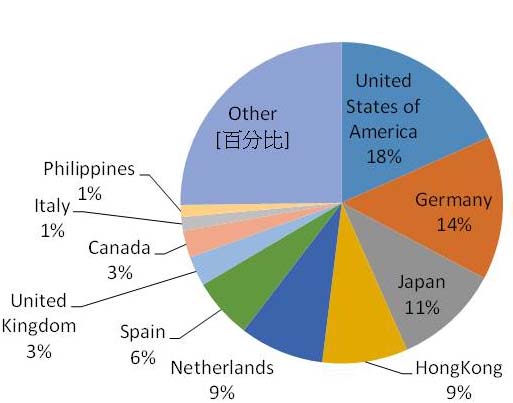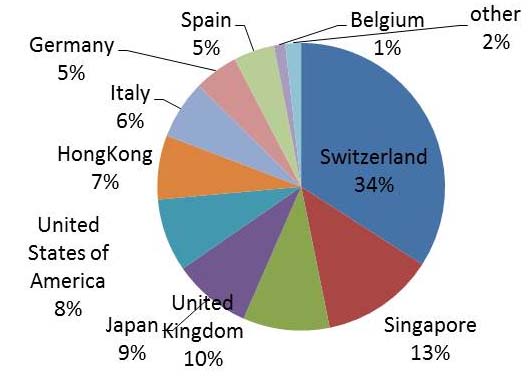ABSTRACT
In recent years, coffee has been Vietnam's important agricultural export product. Vietnam's coffee production always leads the world in Robusta coffee. In the past two years, the export of processed coffee has increased significantly in comparison with that of coffee beans, but the amount of wet-processed coffee is still limited. In addition, the overuse of pesticides and fertilizers is still very popular although 4C, Rainforest, UTZ and Fairtrade coffee standards have been implemented by local coffee companies. Therefore, the quality of Vietnam's coffee has not been appreciated when compared to that of other countries like Brazil or Colombia. This requires the coffee industry to change and adapt to the market and apply more sustainable production standards.
INTRODUCTION
Vietnam’s coffee export
Vietnam’s coffee export in 2016 reached 1.79 million tons and $US 3.36 billion, up 33.6% in volume and up 25.6% in value against 2015. Average coffee export price in 11 months 2016 reached $US 1,840/ton, down 8.6% over the same period in 2015.

Fig. 1. Volume and value of Vietnam’s coffee export in 2016
Source: General Department of Vietnam Customs, 2016
In 2016, the volume of processed coffee, especially instant coffee and powdered coffee, reached 15.34% of total exports. The major coffee export of Vietnam is still Robusta coffee beans (79%). Other types of coffee exported are Arabica (4.9%) and excelsa (0.24%).

Fig. 2. Coffee exports of Vietnam by groups, types of processing
Source: General Department of Vietnam Customs, 2016
Meanwhile, the coffee beans which are unleavened, decaffeinated are reduced by 9% to 88.8%. Meanwhile, the proportion of wet-processed coffee in 2016 is only 20%, up more than 5% when compared to 2015 but is still relatively low. The amount of dry-processed coffee is much, so the rate of bean breakage is high, therefore the price of Vietnam coffee is often lower than that of countries like Brazil and Indonesia.

Fig. 3. Vietnam’s coffee exports by categories
Source: General Department of Vietnam Customs, 2016
Vietnam is always known as the largest producer of robusta coffee in the world. At the same time, it is also the second largest coffee producer in the world. Germany and the US are still the two largest importers of robusta from Vietnam with a market share of 14% and 18%, respectively.

Fig. 4. Structure of Vietnam’s robusta importers, 2016
Source: General Department of Vietnam Customs, 2016
Vietnam’s Arabica coffee is not planted widely, and are mainly grown in some areas like Lam Dong, Quang Tri and some mountainous provinces in the north such as Son La, Lao Cai. Every year Vietnam also exports about 40.000 – 50.000 tons of Arabica coffee and earns $US 130 million.

Fig. 5. Vietnam’s arabica coffee import market
Source: General Department of Vietnam Customs, 2016
In the Central Highlands, excelsa coffee often blooms and is harvested later than other coffee species due to its rain-blooming essence, and is usually harvested in December of the lunar calendar, after other coffee species have been harvested. The output of excelsa coffee is not much with large slender white kernel. Excelsa coffee trees are usually thoroughbred or used as wind-breaking forest belts for robusta coffee plots, usually planted in rows at a distance of 5-7m per tree.
Excelsa coffee seeds are often mixed with robusta, arabica coffee during the process of roasting or grounding to create flavor. Excelsa coffee often meets the taste of European consumers. The European type of instant coffee usually has a high percentage of excelsa coffee, so often characterized by sour taste.

Fig. 6. Vietnam’s excelsa coffee import market, 2016
Source: General Department of Vietnam Customs, 2016
In recent years, excelsa coffee area remains stable, estimated at 400-500 ha. In 2016, Vietnam exported excelsa coffee mainly to Belgium (41%), Switzerland (24%), Hong Kong (24%), and USA (10%).
Processed coffee is being used extensively in the world and is gradually replacing the traditional coffee, which uses powder or grounded coffee beans. Vietnam also has instant 3 in 1, 2 in 1 coffee brands like Trung Nguyen, Vinacafe, Nestle, etc. These types of coffee have been exported quite a lot in recent years to the European and Asian markets.

Fig. 7. Export markets (instant, powder, 3 in 1 coffee) of Vietnam 2016
Source: General Department of Vietnam Customs, 2016
In 2015, exports of soluble coffee, powdered and 3 in 1, 2 in 1 coffee of Vietnam increased quite high, up to 15% of the total export turnover. Main export markets are Switzerland (34%), Singapore (13%), and Japan (9%). These three countries account for 50% of the total export turnover of this type of coffee.
Along with the requirement of higher quality foods in the world market especially in the aspect of food safety, the adaptation of sustainable standards in coffee production in Vietnam has recently been increasing. The linkages between domestic exporters/international roasters and farmers are improved. It is estimated that around 20,000 farming households are supported by companies such as Simexco, Vinacafe, Nestle and ACOM to produce sustainable coffee production. In the period 2001-2014 the coffee production was certified by organizations such as the Tropical Rain Forest Organization, UTZ Certified, Fairtrade International, 4C Association increases stably in recent years. Particularly, the certification by the 4C Association has grown very fast from 450.000 tons in 2013 to 600.000 tons in 2014 (Fig. 8).

Fig. 8. Vietnam’s certified coffee output
Source: 4C Association
In terms of certified coffee area, Vietnam is the third country in the world next to Brazil and Colombia. The certified coffee acreage of Vietnam was 191.000 hectares in 2014 and this number is expected to reach 300,000 hectares by 2017. Therefore, this is a good opportunity for the Vietnam coffee industry to sustainably develop, raising its selling price, improve its product quality and access to the world's premium coffee markets.

Fig. 9. Rapid increase in certified coffee area
Source: 4C Association
The rejection of Vietnam export coffee by importers
Although the coffee which has been certified with international standards in Vietnam has been increasing recently, uncertified coffee area still accounts for over 60% of the total area. In addtion, coffee harvest and post harvest activities still lack improvement. This makes coffee quality production low and has been continously down graded after harvesting. These problems cause Vietnamese coffee to be rejected by importers. For example, in the 2005/2006 season, the amount of coffee removed on the LIFFE market (London term market - England) was about 708,250 bags, of which Vietnam accounted for over 88%, up by 19% in comparison with the previous crop. The rejection of importers are much reduced in recent years but it still happens. In 2015, two Vietnam coffee exporters had also rejected their coffee to EU not due to product quality but the wrong packing process with technical standards of importers (Văn Minh Hoa, 2007). Recently, the export volume of Vietnam‘s coffee has achieved stable growth. However, improvement in quality is also important when SPS standards are continuously being raised by importers.
CONCLLUSION
Recently, Vietnam’s coffee exports had improved both in terms of volume and quality. There have been improvement in the types of coffee exports. Total export of processed coffee has been increasing significantly, accounting for 15% of the total export value in 2016. Vietnam’s coffee are exported to many countries, but the main markets are United States and Germany. Asia is the fastest growing coffee consuming market, of which, Vietnam is considered a potential one. That leads to the fact that Vietnam needs more investments in these markets, especially the domestic one.
With the high proportion of green bean harvested by farmers and only 20 % of coffee wet-processing, Vietnam’s coffee quality is still inconsistent and sometimes low. Therefore, it is essential to further improve the harvest techniques and investments in coffee processing for better
Competition and reputation in the export market in Vietnam needs improvement in coffee production, post-harvest activities and value chain management. The quality could be controlled from the farm stage to processing and trading. At the same time, the area allotted to certified coffee could further be increased such as 4C, Rainforest, UTZ, Fairtrade. Government support is likewise necessary to further improve the coffee industry.
REFERENCES
GSO, 2014. Macroeconomic report of Vietnam in 2014, Statistical publishing house, Hanoi
AROINFO, 2016. Overview of the coffee market in 2015 and outlook for 2016, Hanoi
Văn Minh Hoa, 2007. Alert the quality of coffee, http://www.sggp.org.vn/bao-dong-chat-luong-ca-phe-331134.html
4C Association, 2013. Annual report 2014.
|
Date submitted: Nov. 8, 2017
Reviewed, edited and uploaded: Dec. 26, 2017
|


Vietnam Coffee Export: Improvement in Both Quantity and Quality
ABSTRACT
In recent years, coffee has been Vietnam's important agricultural export product. Vietnam's coffee production always leads the world in Robusta coffee. In the past two years, the export of processed coffee has increased significantly in comparison with that of coffee beans, but the amount of wet-processed coffee is still limited. In addition, the overuse of pesticides and fertilizers is still very popular although 4C, Rainforest, UTZ and Fairtrade coffee standards have been implemented by local coffee companies. Therefore, the quality of Vietnam's coffee has not been appreciated when compared to that of other countries like Brazil or Colombia. This requires the coffee industry to change and adapt to the market and apply more sustainable production standards.
INTRODUCTION
Vietnam’s coffee export
Vietnam’s coffee export in 2016 reached 1.79 million tons and $US 3.36 billion, up 33.6% in volume and up 25.6% in value against 2015. Average coffee export price in 11 months 2016 reached $US 1,840/ton, down 8.6% over the same period in 2015.
Fig. 1. Volume and value of Vietnam’s coffee export in 2016
Source: General Department of Vietnam Customs, 2016
In 2016, the volume of processed coffee, especially instant coffee and powdered coffee, reached 15.34% of total exports. The major coffee export of Vietnam is still Robusta coffee beans (79%). Other types of coffee exported are Arabica (4.9%) and excelsa (0.24%).
Fig. 2. Coffee exports of Vietnam by groups, types of processing
Source: General Department of Vietnam Customs, 2016
Meanwhile, the coffee beans which are unleavened, decaffeinated are reduced by 9% to 88.8%. Meanwhile, the proportion of wet-processed coffee in 2016 is only 20%, up more than 5% when compared to 2015 but is still relatively low. The amount of dry-processed coffee is much, so the rate of bean breakage is high, therefore the price of Vietnam coffee is often lower than that of countries like Brazil and Indonesia.
Fig. 3. Vietnam’s coffee exports by categories
Source: General Department of Vietnam Customs, 2016
Vietnam is always known as the largest producer of robusta coffee in the world. At the same time, it is also the second largest coffee producer in the world. Germany and the US are still the two largest importers of robusta from Vietnam with a market share of 14% and 18%, respectively.
Fig. 4. Structure of Vietnam’s robusta importers, 2016
Source: General Department of Vietnam Customs, 2016
Vietnam’s Arabica coffee is not planted widely, and are mainly grown in some areas like Lam Dong, Quang Tri and some mountainous provinces in the north such as Son La, Lao Cai. Every year Vietnam also exports about 40.000 – 50.000 tons of Arabica coffee and earns $US 130 million.
Fig. 5. Vietnam’s arabica coffee import market
Source: General Department of Vietnam Customs, 2016
In the Central Highlands, excelsa coffee often blooms and is harvested later than other coffee species due to its rain-blooming essence, and is usually harvested in December of the lunar calendar, after other coffee species have been harvested. The output of excelsa coffee is not much with large slender white kernel. Excelsa coffee trees are usually thoroughbred or used as wind-breaking forest belts for robusta coffee plots, usually planted in rows at a distance of 5-7m per tree.
Excelsa coffee seeds are often mixed with robusta, arabica coffee during the process of roasting or grounding to create flavor. Excelsa coffee often meets the taste of European consumers. The European type of instant coffee usually has a high percentage of excelsa coffee, so often characterized by sour taste.
Fig. 6. Vietnam’s excelsa coffee import market, 2016
Source: General Department of Vietnam Customs, 2016
In recent years, excelsa coffee area remains stable, estimated at 400-500 ha. In 2016, Vietnam exported excelsa coffee mainly to Belgium (41%), Switzerland (24%), Hong Kong (24%), and USA (10%).
Processed coffee is being used extensively in the world and is gradually replacing the traditional coffee, which uses powder or grounded coffee beans. Vietnam also has instant 3 in 1, 2 in 1 coffee brands like Trung Nguyen, Vinacafe, Nestle, etc. These types of coffee have been exported quite a lot in recent years to the European and Asian markets.
Fig. 7. Export markets (instant, powder, 3 in 1 coffee) of Vietnam 2016
Source: General Department of Vietnam Customs, 2016
In 2015, exports of soluble coffee, powdered and 3 in 1, 2 in 1 coffee of Vietnam increased quite high, up to 15% of the total export turnover. Main export markets are Switzerland (34%), Singapore (13%), and Japan (9%). These three countries account for 50% of the total export turnover of this type of coffee.
Fig. 8. Vietnam’s certified coffee output
Source: 4C Association
In terms of certified coffee area, Vietnam is the third country in the world next to Brazil and Colombia. The certified coffee acreage of Vietnam was 191.000 hectares in 2014 and this number is expected to reach 300,000 hectares by 2017. Therefore, this is a good opportunity for the Vietnam coffee industry to sustainably develop, raising its selling price, improve its product quality and access to the world's premium coffee markets.
Fig. 9. Rapid increase in certified coffee area
Source: 4C Association
The rejection of Vietnam export coffee by importers
Although the coffee which has been certified with international standards in Vietnam has been increasing recently, uncertified coffee area still accounts for over 60% of the total area. In addtion, coffee harvest and post harvest activities still lack improvement. This makes coffee quality production low and has been continously down graded after harvesting. These problems cause Vietnamese coffee to be rejected by importers. For example, in the 2005/2006 season, the amount of coffee removed on the LIFFE market (London term market - England) was about 708,250 bags, of which Vietnam accounted for over 88%, up by 19% in comparison with the previous crop. The rejection of importers are much reduced in recent years but it still happens. In 2015, two Vietnam coffee exporters had also rejected their coffee to EU not due to product quality but the wrong packing process with technical standards of importers (Văn Minh Hoa, 2007). Recently, the export volume of Vietnam‘s coffee has achieved stable growth. However, improvement in quality is also important when SPS standards are continuously being raised by importers.
CONCLLUSION
Recently, Vietnam’s coffee exports had improved both in terms of volume and quality. There have been improvement in the types of coffee exports. Total export of processed coffee has been increasing significantly, accounting for 15% of the total export value in 2016. Vietnam’s coffee are exported to many countries, but the main markets are United States and Germany. Asia is the fastest growing coffee consuming market, of which, Vietnam is considered a potential one. That leads to the fact that Vietnam needs more investments in these markets, especially the domestic one.
With the high proportion of green bean harvested by farmers and only 20 % of coffee wet-processing, Vietnam’s coffee quality is still inconsistent and sometimes low. Therefore, it is essential to further improve the harvest techniques and investments in coffee processing for better
Competition and reputation in the export market in Vietnam needs improvement in coffee production, post-harvest activities and value chain management. The quality could be controlled from the farm stage to processing and trading. At the same time, the area allotted to certified coffee could further be increased such as 4C, Rainforest, UTZ, Fairtrade. Government support is likewise necessary to further improve the coffee industry.
REFERENCES
GSO, 2014. Macroeconomic report of Vietnam in 2014, Statistical publishing house, Hanoi
AROINFO, 2016. Overview of the coffee market in 2015 and outlook for 2016, Hanoi
Văn Minh Hoa, 2007. Alert the quality of coffee, http://www.sggp.org.vn/bao-dong-chat-luong-ca-phe-331134.html
4C Association, 2013. Annual report 2014.
Date submitted: Nov. 8, 2017
Reviewed, edited and uploaded: Dec. 26, 2017